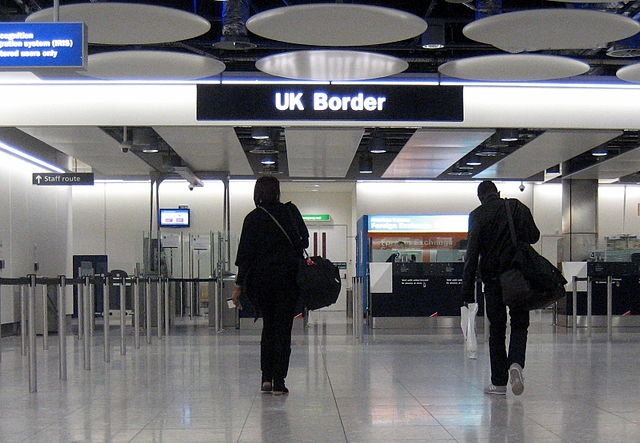The UK government has just issued its official position paper on the issue of the customs union and Brexit. It emphasises a desire for the “most frictionless trade possible in goods between the UK and the EU” and proposes two ways of achieving this in the long term, while making it clear that the UK will leave the EU’s customs union when it leaves the EU.
The first option it proposes is a “streamlined customs arrangement” which sounds like a form of free trade agreement (but there is no mention of this as an aim). It involves keeping in place a number of the existing customs arrangements and using (untested) electronic technology to ensure the smooth processing of all documentation. The stated aim is to keep border arrangements as close as possible to what they are now to maintain continuity for businesses.
The second possibility is an untried concept of “a new customs partnership”. Exactly what this will involve is only hinted at, but not spelled out. It involves applying EU tariffs on goods that are destined for final consumption in the EU.
In the meantime, by March 2019, the UK is to have in place a new temporary customs union arrangement with the EU, under which nothing changes except that the UK will have no say in its tariffs, but can potentially negotiate (but not apply) free trade agreements with third countries.
This is extremely ambitious, to say the least. It is not impossible, but it effectively means negotiating the most complex customs union that exists outside the EU for a three-year interim period and then getting rid of it. And, crucially, relies on the EU accepting the proposal.
Same, but different
By definition, the kind of customs union the UK is proposing with the EU is not the same as the one it is leaving. A customs union is a type of trade agreement whereby members agree to abolish all tariffs on trade between them and to have a common external tariff on goods coming in from third countries. This allows members to dispense with the need for customs posts at borders and lets trade go through much more smoothly (and quickly).
In practice, trade agreements can be registered at the World Trade Organisation (WTO) as “customs unions” so long as “substantially all” trade is covered. This means that border checks are still necessary to deal with any traffic that may contain goods not exempt from tariffs. For example, Turkey has a customs union deal with the EU but it does not cover agricultural goods so every truck has to be checked for these at the border crossing.
On the other hand, a free trade area (such as the EEA) is a group of countries that don’t charge tariffs on the products “originating” from other member states but do not have a common external tariff. There are customs checks within free trade areas to ensure that tariffs are collected on third country goods as they cross an internal frontier and also to collect tariffs on goods made in partner countries that use imported materials in large quantities. Every consignment crossing a border must have documentation confirming its origin, a requirement that does not exist for a customs union.
This all goes back to the original purpose of the EU. It started out as a customs union that had removed tariffs on trade by 1969, but there still remained customs barriers for non-tariff purposes such as checking technical standards compliance. By 1992, this had evolved into the EU single market, allowing for the free flow of goods and services – and no border checks.
Norway is a member of the single market but is not in the customs union. This means its technical standards and verification testing and certification procedures for these are harmonised with the EU, with supra-national enforcement. Lorries travelling between Norway and Sweden (which is in the EU) are potentially subject to border checks for whether their load satisfies rules of origin, but there are no technical checks.
It is the combination of the customs union and single market that created a genuinely frictionless market. Leaving the customs union means that, without a free trade agreement, the UK and the EU must in principle charge tariffs on each other’s products under WTO rules. And unless an agreement has been reached to recognise UK regulations and standards, there will still need to be technical checks on goods for safety. Clearly, in practice, there would be spot checks on vehicles at the UK-EU border.
Outside of a free trade agreement with the EU, the UK would need to ensure comprehensive paperwork to document compliance with EU rules and origin status. This would also involve random spot checks at borders to verify the paperwork was in order and also some more time-consuming physical checks to ensure the paperwork and the physical goods matched.
Reality bites
The government’s new paper addresses many of these issues – but largely in aspirational terms. Its emphasis on the power of technology to smooth over the transition fails to take into account that physical checks will be necessary – something Norway has found in its cross-border trade with Sweden. This means the first option of a “streamlined” customs arrangement will likely still involve a lot of red tape and delays for businesses, which must prove they meet the EU’s standards.
It is also very hard to see how the second option proposed of “a new customs partnership with the EU” could work. The position paper’s suggestion that the UK could mimic the EU external tariffs for goods destined for consumption in the EU (in the hope that this would exempt them from further customs checks) would involve complex tracking procedures. This would be extremely hard to apply to components buried inside finished products.
It would also require a supra-national mechanism to enforce or at least monitor compliance with EU standards, if EU states are not to have the right to stop UK goods at the border. Yet there is not much appetite for supra-national bodies in the UK – after all, the whole point of Brexit was to “take back control”.
Having said all this, the question remains: why would the EU accept these proposals? The UK suggests that it would be in everyone’s economic interests to do so, but EU officials have already expressed scepticism. It could well be wishful thinking – if not some kind of negotiating strategy by the UK government.
 Peter Holmes does not currently receive any funding for Brexit-related research. He is affiliated with the UK Trade Policy observatory (UKTPO), a partnership between the University of Sussex and Chatham House, and is a member of the Labour Party.
Peter Holmes does not currently receive any funding for Brexit-related research. He is affiliated with the UK Trade Policy observatory (UKTPO), a partnership between the University of Sussex and Chatham House, and is a member of the Labour Party.



 Gym hygiene guide: the dangerous bacteria that lurk in dirty fitness equipment and clothes
Gym hygiene guide: the dangerous bacteria that lurk in dirty fitness equipment and clothes  Why are blooper reels so funny?
Why are blooper reels so funny?  Why doesn’t my digital music feel like ‘mine’? Three ways digital possessions reduce our sense of ownership
Why doesn’t my digital music feel like ‘mine’? Three ways digital possessions reduce our sense of ownership  Japan Posts 7.7% Growth in Machinery Orders
Japan Posts 7.7% Growth in Machinery Orders  Why is toddler milk so popular? Follow the money
Why is toddler milk so popular? Follow the money  Why China’s economy has hit a wall
Why China’s economy has hit a wall  An education in music makes you a better employee. Are recruiters in tune?
An education in music makes you a better employee. Are recruiters in tune?  The idea that US interest rates will stay higher for longer is probably wrong
The idea that US interest rates will stay higher for longer is probably wrong  If you squat in a vacant property, does the law give you the house for free? Well, sort of
If you squat in a vacant property, does the law give you the house for free? Well, sort of  Vladimir Putin’s gold strategy explains why sanctions against Russia have failed
Vladimir Putin’s gold strategy explains why sanctions against Russia have failed  In a time of information overload, enigmatic philosopher Byung-Chul Han seeks the re-enchantment of the world
In a time of information overload, enigmatic philosopher Byung-Chul Han seeks the re-enchantment of the world 































